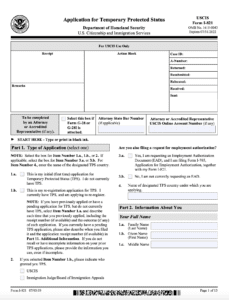Judge Hanen Finds DACA Unlawful for a Second Time
Judge Andrew Hanen of the Southern District of Texas this week again found DACA to be unlawful. (DACA is the Deferred Action for Childhood Arrivals administrative amnesty program for illegal aliens claiming to have come to the U.S. as minors.) The judge also found the program to be unlawful in 2021, a decision affirmed last year by the 5th Circuit. However, the appellate court remanded the case back to Judge Hanen because in the interim, DHS had promoted DACA from a written-on-the-back-of-a-paper-bag memo (the “Napolitano memo”) by Janet Napolitano, President Obama’s secretary of Homeland Security, to a formal final regulation. As Judge Hanen notes in this week’s ruling, the 5th Circuit “lacking the complete administrative record, remanded the consideration of the Final Rule to this Court” in order to “determine whether the Final Rule suffers from the same fatal deficiencies as [the “Napolitano memo].” The 5th Circuit had concluded that “A district court is in the best position to review the administrative record in the rulemaking proceeding and determine whether our holdings as to the [Napolitano memo] fully resolve issues concerning the Final Rule.”
Judge Hanen’s unsurprising conclusion is that “[T]he Final Rule substantively violates the APA [Administrative Procedure Act] and is unlawful for the same reasons as the [Napolitano memo].” He explains that:
-
[T]he easy response to the assignment given to this Court on remand is: there are no material differences between the Final rule and the [Napolitano memo]… . DHS did nothing to change or resolve the substantive problems found by this Court or the Fifth Circuit. Indeed, much to their counsel’s credit, the [Biden administration] candidly admit[s] that the Final rule suffers from the same problems … and that it is contrary to the Fifth Circuit’s opinion.
-
[T]he Final Rule was purposefully designed to preserve the [Napolitano memo] as written. DHS has merely formalized [it], a program the Fifth Circuit already found to be wanting … . [and] also intends for [DACA] to be interpreted just as it has been for the last decade.
-
The creation and adoption of the Final Rule took no steps to avoid any of the substantive pitfalls that have been pointed out by the Fifth Circuit or other courts — perhaps because DHS did not want to, or perhaps because it was not possible to do so and retain the DACA program as currently constituted.
The really interesting and important aspect of Judge Hanen’s opinion is the distinction he draws between “deferred action” and “forbearance”. He writes that:
-
DHS does not need the Final Rule to exercise forbearance as to the DACA recipient population. The DHS has always had the right and the power to prosecute or forbear from prosecution any person illegally present in the country, even without an administrative rule or memorandum.
-
DHS has always had the inherent power — on a case-by-case basis — to exercise prosecutorial discretion with or without a regulation. It was already doing this before [the creation of DACA], so a forbearance only policy changes nothing. If this Court were to take away the deferred action status (and all the resulting benefits), the DACA recipients would be back where they were — in the country illegally, but not active targets of the DHS … . DHS does not need a rule to enable it to not prosecute someone.
-
This “non-prosecution” vs. “non-prosecution with benefits” difference is a key distinction that both this Court and the Fifth Circuit made … . [I]n both cases, this Court emphaszed that no part of its orders should be read as interfering with the enforcement, non-enforcement, or prosecutorial decisions that are an inherent part of DHS’s field of operations.
The distinction drawn by Judge Hanen is so important because it corrects the Supreme Court’s conflation of forbearance and deferred action. And that is important because while forbearance represents the every-day, ordinary exercise of law enforcement officials’ inherent power of prosecutorial discretion, the grant of deferred action when not authorized by Congress is unlawful, at least when granted to classes of illegal aliens.
To explain, I need to go back to Chief Justice Roberts’ majority opinion in the Supreme Court’s 2020 decision in DHS v. Regents of the University of California, in which the Court unexpectedly invalidated the Trump administration’s recission of the DACA program. In Regents, Roberts chose to not even decide whether DACA was lawful. He instead concluded that the program’s termination violated the APA in essentially two ways: DHS had not considered (1) the alternative of cutting off access to “benefits” without ending “forbearance” and (2) the “reliance interests” built up by DACA applicants who had received forbearance.
To Roberts, the “benefits” are those flowing to DACA beneficiaries as a result of being granted deferred action — including being considered as “lawfully present”, and eligibility for work authorization and federal welfare benefits — while “forbearance” is the receipt of deferred action itself. As he stated in his opinion:
-
[F]orbearance was … the centerpiece of the policy: DACA, after all, stands for “Deferred Action for Childhood Arrivals.”
-
The defining feature of deferred action is the decision to defer removal (and to notify the affected alien of that decision) … . And the Fifth Circuit was careful to distinguish that forbearance component from eligibility for benefits. As it explained, the “challenged portion of DAPA’s deferred-action program” was the decision to make DAPA recipients eligible for benefits … . The other “[p]art of DAPA,” the court noted, “involve[d] the Secretary’s decision — at least temporarily — not to enforce the immigration laws as to a class of what he deem[ed] to be low-priority illegal aliens.” [Emphasis added.]
The Supreme Court was only able to rule in this manner because of the apparent conclusion of the 5th Circuit and the Trump administration that forbearance (in the sense of the grant of deferred action) was not in and of itself unlawful. I have written that the states that challenged in federal court President Obama’s sibling Deferred Action for Parents of Americans (“DAPA”) program (for the illegal alien parents of U.S. citizens and permanent residents), the 5th Circuit in its DAPA decision, and the Trump administration in its defense of its DACA recission all seemingly concluded that DAPA/DACA’s unlawfulness stemmed solely from the benefits, not also from the programs’ forbearance.
The 5th Circuit in its 2015 decision in Texas v. U.S. affirming Judge Hanen’s injunction against DAPA concluded that:
-
DAPA would make 4.3 million otherwise removable aliens eligible for lawful presence, employment authorization, and associated benefits.
-
The INA flatly does not permit the reclassification of millions of illegal aliens as lawfully present and thereby make them newly eligible for a host of federal and state benefits, including work authorization.
-
[T]he states’ claims. … stem from his decision to grant lawful presence to millions of illegal aliens on a class-wide basis.
Chief Justice Roberts certainly believed that the 5th Circuit had concluded that DAPA’s grant of benefits is what makes it unlawful:
-
Attorney General [Jeff Sessions] concluded that “the DACA policy has the same legal … defects that the courts recognized as to DAPA.” … So, to understand those defects, we look to the Fifth Circuit, the highest court to offer a reasoned opinion on the legality of DAPA. That court described the “core” issue before it as the “Secretary’s decision” to grant “eligibility for benefits” — including work authorization, Social Security, and Medicare — to unauthorized aliens on “a class-wide basis.” … The Fifth Circuit’s focus on these benefits was central to every stage of its analysis.
-
[The Fifth Circuit] ultimately held that DAPA was “manifestly contrary to the INA” precisely because it “would make 4.3 million otherwise removable aliens” eligible for work authorization and public benefits.
This enabled Roberts to conclude that:
-
DHS could have addressed … Attorney General [Session]’s determination that such benefits were impermissible … by … exclud[ing] DACA recipients from those benefits without rescinding the [Napolitano memo] and the forbearance policy it established. But [Acting Secretary of Homeland Security Elaine] Duke’s rescission memo shows no cognizance of this possibility.
-
Even if it is illegal for DHS to extend work authorization and other benefits to DACA recipients, that conclusion supported only “disallow[ing]” benefits … . It did “not cast doubt” on the legality of forbearance … . [T]he [Napolitano memo] could not be rescinded in full “without any consideration whatsoever” of a forbearance-only policy.
-
[Acting Secretary of Homeland Security Elaine Duke] entirely failed to consider [that] important aspect of the problem.”
…
That omission alone renders Acting Secretary Duke’s decision arbitrary and capricious.
In any event, as Judge Hanen understands, there is a crucial distinction between forbearance and deferred action. Unfortunately, Chief Justice Roberts has confused deferred action (forbearance in his mind) with simple priority-setting, the decision to “decline to institute proceedings, terminate proceedings, or decline to execute a final order of deportation”, as did the Supreme Court in its 1999 decision in Reno v. American-Arab Anti-Discrimination Committee.
There is a profound difference between, on the one hand, declining to devote resources to institute removal proceedings against a particular alien and, on the other hand, formally notifying aliens, especially classes of aliens, that the government promises to ignore their unlawful conduct. The Napolitano memo stated that the goal of DACA was “to prevent low priority individuals from being removed from the United States”. The administration was affirmatively proclaiming that a duly enacted law would not (and should not) be enforced against a class of violators even were the administration to be blessed with unlimited resources. That is quite far afield from simply diverting limited prosecutorial resources to higher priorities.
As the states argued in their complaint challenging DAPA, one of the “important differences between” DAPA “and exercises of enforcement discretion” is that “deferred action is not merely a “decision not to prosecute an individual for past unlawful conduct”, rather it is “a decision to openly tolerate an undocumented alien’s continued presence in the United States”.
And as the Trump administration pointed out to the Supreme Court:
-
[I]nforming roughly 1.7 million aliens that they may continue violating federal law without fear of enforcement — while establishing a procedure to make them eligible for additional benefits — goes well beyond strategically directing the agency’s resources to the highest priority violators. It instead deploys those resources on a massive scale in a manner that will undermine the deterrent effect of federal law by facilitating its continuing violation.
-
[A]t most, that justifies a decision not to deploy limited resources to remove low-priority targets … . [I]t does not justify deploying those limited resources in a manner that facilitates ongoing violation of federal law by a massive number of aliens. There is an obvious difference between not pursuing lower-priority offenses … and affirmatively assisting lower-priority offenders to persist in ongoing illegal activity. [Emphasis added.]
The states’ complaint cited an Obama Justice Department 2014 Office of Legal Counsel memo that concluded that:
Deferred action … differs in at least three respects from more familiar and widespread exercises of enforcement discretion. First, unlike … the paradigmatic exercise of prosecutorial discretion in a criminal case, the conferral of deferred action does not represent a decision not to prosecute an individual for past unlawful conduct; it instead represents a decision to openly tolerate an undocumented alien’s continued presence in the United States for a fixed period (subject to revocation at the agency’s discretion). Second, unlike most exercises of enforcement discretion, deferred action carries with it benefits in addition to nonenforcement itself; specifically, the ability to seek employment authorization and suspension of unlawful presence … . Third, class-based deferred action programs … do not merely enable individual immigration officials to select deserving beneficiaries from among those aliens who have been identified or apprehended for possible removal — as is the case with ad hoc deferred action — but rather set forth certain threshold eligibility criteria and then invite individuals who satisfy these criteria to apply for deferred action status. [Emphasis added.]
Now, OLC went on to nonetheless conclude that:
While these features of deferred action are somewhat unusual among exercises of enforcement discretion, the differences between deferred action and other exercises of enforcement discretion are less significant than they might initially appear. The first feature — the toleration of an alien’s continued unlawful presence — is an inevitable element of almost any exercise of discretion in immigration enforcement. Any decision not to remove an unlawfully present alien — even through an exercise of routine enforcement discretion —necessarily carries with it a tacit acknowledgment that the alien will continue to be present in the United States without legal status. Deferred action arguably goes beyond such tacit acknowledgment by expressly communicating to the alien that his or her unlawful presence will be tolerated for a prescribed period of time. This difference is not, in our view, insignificant. But neither does it fundamentally transform deferred action into something other than an exercise of enforcement discretion.
Contrary to OLC, expressly communicating to aliens that their unlawful presence will be tolerated for a prescribed period of time does indeed fundamentally transform deferred action into something other than an exercise of enforcement discretion. This is if only because of the “observer effect”. As the saying goes in quantum mechanics, “the process of observing a particle changes the way the particle behaves”. In the more rarefied realm of Chief Justice Roberts’ jurisprudence, “expressly communicating” to an alien gives the alien the very reliance interest upon which he invalidated DHS’ termination of DACA! So, it is very much more than simply an exercise in enforcement discretion. By notifying the alien of the decision, the foundation for reliance has been established.
I can only hope that Chief Justice Roberts and the rest of the Supreme Court take Judge Hanen’s opinion to heart and come to realize that prosecutorial discretion and class-wide deferred action policies are poles apart. The former is an inherent part of the rule of law, the latter is an inherent attack upon it.






